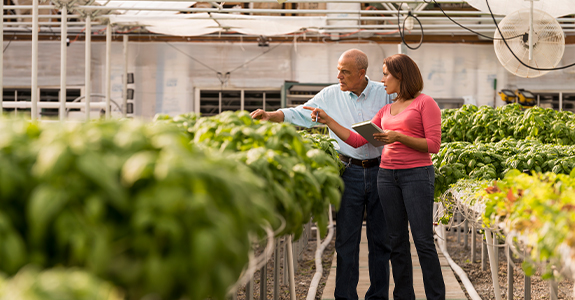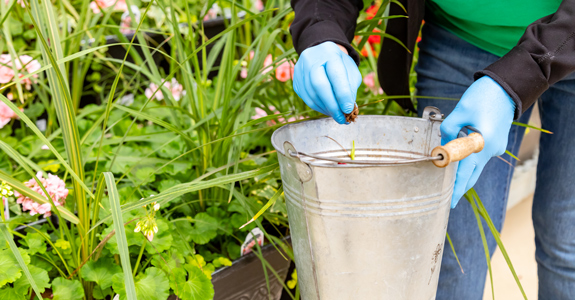Safety strategies for your garden center and greenhouse

Your garden center and greenhouse are businesses people visit to enjoy the beauty of plants and indulge their love of gardening. However, these facilities can introduce their share of safety hazards—from heavy equipment and inventory-filled racks to wet surfaces and cluttered walkways.
Taking a proactive stance on safety not only helps safeguard your customers and employees from accidents and injuries—it can help protect your business’s bottom line.
Common hazards in garden centers and greenhouses
When customers visit your business, they expect a combination of on-demand customer service and physical safety. As a business owner, it’s your responsibility to inspect your property for any dangerous situations and keep your grounds in safe condition.
Walk around your property daily to identify—and mitigate—potential hazards, including:
Wet floors and puddles
Sharp or protruding objects
Heavy machinery
Chemical storage areas
Unrolled hoses or extension cords
Uneven or cracked surfaces
Slips and falls
Slip-and-fall hazards at garden centers and greenhouses can pose a significant risk of severe injuries. According to the Consumer Product Safety Commission (CPSC), floors and flooring materials contribute directly to more than 2 million fall injuries each year, with associated medical costs of $14 million per year in the U.S.
How to help prevent workplace slips and falls
To help reduce your slip-and-fall risk at your horticultural business, prioritize daily maintenance and housekeeping:
Keep floors clean and dry
Address spills immediately
Use mats or other non-slip surfaces in areas where water is likely to be present
Repair any uneven or cracked surfaces
Clear walkways of boxes, tools, and equipment—even hanging baskets, which take focus off the floor
Free loss control and safety materials are available to all Hortica customers.
A hypothetical slip-and-fall injury example
On a rainy day, visitors and employees at a garden center tracked water and mud onto an uncarpeted retail area. An employee walking across the retail area slipped and fell on the wet surface, resulting in injuries to her hip and shoulder, as well as closed-head trauma.
She suffered permanent partial disability to her hip and shoulder, requiring significant medical treatment. Healing problems resulted in a 25% disability rating, and her head injury led to a cognitive deficiency that prevented her from returning to her position.
Between medical, disability, and retraining expenses, total costs for this case exceeded $825,000. The business also incurred uninsured costs for elevated insurance premiums, negative public image, and a punitive jury award.
The investigation identified gaps in maintenance of the tile flooring. The floor coverings routinely became oversaturated during wet weather, but the business had no procedures in place to change them as needed. Additionally, the business hadn’t taken steps to remind employees to wear proper footwear during wet weather.
How to establish a horticultural workplace safety program
Safety plays a crucial role in the success of any horticultural business. However, building a culture of safety from scratch can be challenging.
It requires a collective effort and a strong commitment from management to model behaviors that prioritize safety and foster a sense of peer-to-peer accountability. Here are several steps you can take to get started:
Why safety matters in your garden center and greenhouse
By prioritizing safety, you demonstrate a commitment to protecting your employees, customers, and assets while also nurturing a culture of trust and longevity within your operation. Focusing on safety also helps you:
Prevent accidents: Maintaining a safe environment can help you reduce the risk of accidents and injuries—and their related costs. The average workplace injury cost was $1,040 per worker in 2022. Fewer accidents and injuries can result in reduced costs related to workers' compensation claims, medical expenses, and legal fees.
Reduce insurance costs: A strong safety record signals to stakeholders your organization prioritizes employee well-being and operates with integrity and responsibility. If you can demonstrate you have a solid safety plan in place, and your business has a good safety record, you could have your insurance premiums reduced.
Avoid legal issues: Safety violations can lead to legal challenges for your greenhouse and garden center, including fines, lawsuits, and expensive claim payouts. Fewer injuries means fewer opportunities for these scenarios.
Improve employee well-being: A safer workplace promotes the well-being of employees, leading to increased job satisfaction, morale, and productivity. On the other hand, 41% of surveyed employees have left an organization because of unsafe conditions.
Enhance customer satisfaction: By harnessing your customers’ perceived safety expectations, your safe shopping environment can create a positive customer experience that also builds true customer loyalty.
We offer customized liability coverages for your garden center.
How can your insurance company help with workplace safety?
Creating a dedicated safety program takes time, planning, and employee buy-in. As a business owner, it may be advantageous to work with your insurance provider who can focus on reviewing your current program and help you build a culture of safety throughout your operations.
Our Loss Control and Safety Services team works with you to help keep your business safe through risk management programs tailored to horticultural business, including:
On-site consultations
Thermographic inspections
Targeted safety presentations
Training materials
Annual claims analysis
If you have questions or would like to learn more about our safety services or greenhouse and garden center insurance coverages, contact us.
You can also reach our Loss Control and Safety Services team at 800-851-7740. We’re here to help you keep your operation running smoothly and efficiently.

Top risks for your horticultural business

Understanding general liability insurance for garden centers

5 steps to a successful safety audit
The information in this article is for informational or entertainment purposes only. View our disclaimer by going to terms and conditions and clicking on Learning Center disclaimer in the table of contents.





